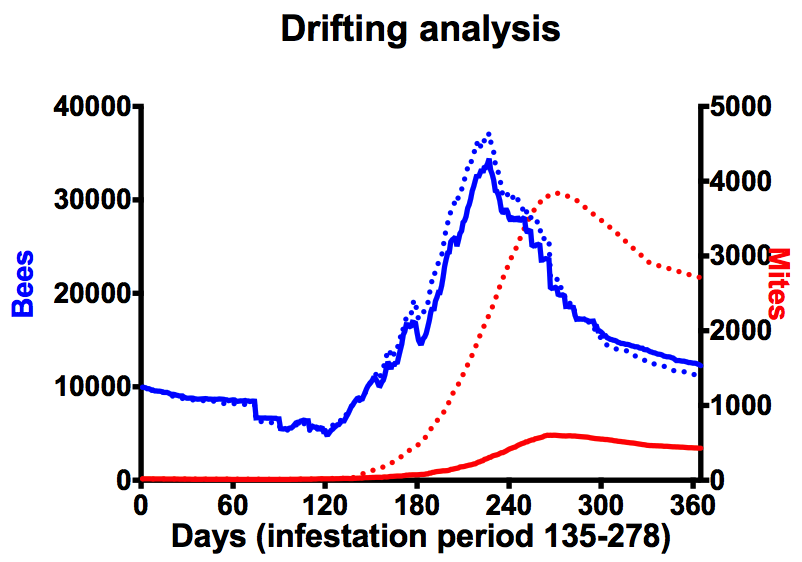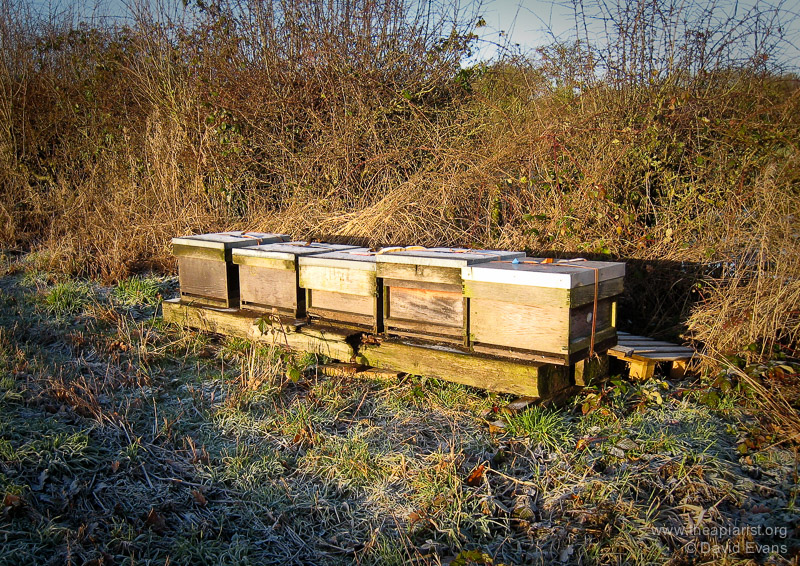The Drifters cont.

The Drifters …
Not the legendary American doo-wap/R&B vocal group but instead a quick follow-up to a recent post on drifting in honey bees. I discovered an interesting article in a 2011 issue of American Bee Journal in which Wyatt Mangum (Mangum, W. [2011] Varroa immigration and resistant mites ABJ 151:475) quantified mites introduced with bees from other colonies. The experiment was straightforward and quite clever … a number of colonies were prepared with very low mite numbers, overwintered and then miticides (unspecified, but from the remainder of the article I’m assuming Apistan) were applied continuously for the rest of the season. This would kill all the mites present. With a Varroa tray in place it was therefore possible to count newly introduced mites throughout the season. These must arrive with drifting workers, drones (not sure if drones ‘drift’ as such … perhaps there’s a better term for their itinerant wandering?), bees that have abandoned other colonies or potentially robbers. The newly infesting mites would of course be killed by the miticide after introduction and before reproduction. They could therefore easily be counted on the Varroa tray under the open mesh floor.
The results were striking … in one year between mid-May and early October an average of 1415 and 1001 mites were introduced to each of the seven ‘recipient’ colonies in two separate apiaries. Mite arrivals weren’t evenly spread, but peaked during a late summer dearth of nectar … perhaps, as suggested by the author, as other colonies started to run out of stores. The source colonies were not identified, but were not within the test apiaries. Whatever the cause, this represents a very significant influx of up to 7-10 mites per day. In Mangum’s experiment these mites could not replicate (due to the miticide that was always present). Had they been able to do so the impact on the recipient colony, in terms of numbers of mites transmitting viruses within the hive, would have been much greater.

The impact of drifting and mite reinfestation
Using BEEHAVE this impact can be modelled. In untreated colonies (solid lines), primed with 20 mites at the beginning of the year (and default conditions as previously described), the average mite level at the year end is ~430 (n=3) having reached a maximum of ~600. Using the same infestation period as reported by Mangum¹, with a mite infestation rate of 7/day (the lowest he observed), the average mite levels at the year end were ~2700 (n=3), with maximum levels reaching ~3800 in late summer (dotted lines). In this simulation the introduced mites can reproduce. Therefore, within just a few months, phoretic mites carried on workers and drones from other colonies, have the potential to raise mite levels in the recipient colony to dangerously high levels – significantly higher than the maximum recommended level of 1000/colony. This is potentially of fundamental importance in strategies to effectively control Varroa. It should be noted that in a repeat of his study this large scale infestation was not observed. This suggests that this type of infestation – from outwith the apiary – may only be a problem in certain years or under specific conditions. One possibility that comes immediately to mind would be a collapsing feral colony or abandoned (or potentially not abandoned, but just completely ignored and untreated … or ‘abandoned‘ as some might say 😉 ) hive within foraging distance.

Ample opportunity …
Interestingly, a recent study has looked at the influence of a number of honey bee pathogens on drifting (or inter-colonial transmission as they rather long-windedly call it) behaviour. Of the viruses, Varroa and Nosema tested, only the presence of high mite levels influenced drifting … but not in the direction that might be expected. Distance between colonies in an apiary was the major factor that influenced drifting and ~17% of tested workers had drifted (with a third to half of these being apparently unrelated to other colonies in the test apiary). Surprisingly, colonies with high Varroa levels were more likely to acquire drifting workers, though the mechanism for this was unclear. The increased mixing through drifting would ensure that these colonies would likely end up with a greater diversity of viral and other pathogens though whether these colonies could, later in the season, act as a source rather than a sink for mites was not tested.

Drone …
Finally, returning to the subject of drifting bees and the ABJ … in the February 2016 issue there’s an interview with Tom Seeley (of Honeybee democracy fame … Sharashkin, L [2016], ABJ 156:157) in which he states that, when quantified, 34% of drones in his apiary colonies were from other hives. This article – on Surviving without Treatments: Lessons from Wild Bees – also discusses the importance of colony separation to coping with Varroa. The feral colonies Seeley studies are located at least half a mile apart in woodland. When recovered and relocated together in apiaries (‘beeyards’ as they’re called in the US) they rapidly succumb to mite-transmitted viral diseases, whereas those maintained some distance apart (30+ metres) survive. Seeley makes the point that pathogens evolving in closely-spaced colonies are likely to be more virulent, whereas those that are in distantly spaced colonies should be less virulent (or they’ll kill the host colony before being transmitted). Seeley is referring to the virulence of Varroa but I think his comments apply better to the viral payload carried by the mite. This is a relatively minor distinction but these observations further emphasise that drifting in honey bees is clearly a major factor in mite, and consequently disease, transmission … and therefore needs to be considered in control.
STOP PRESS – A recent Bee-L post highlighted a further study on the influence of re-infestation. Greatti et al., (1992) showed that ~2-14 mites/day/colony were acquired in their test apiary during June-August, and that this number rose to up to 75 mites/day/colony in September and October². This type of re-infestation can occur by drifting as already discussed, or by workers in the sentinel colonies robbing out mite-infested collapsing nearby hives or feral colonies.
¹In the Mangum study the mites did not infest the sentinel colonies at an even rate of 7+/day. Instead there was a marked peak in mid-season. I’ve not attempted to model this. Clearly if mites don’t arrive earlier in the season the overall levels would be lower (as they wouldn’t have the chance to reproduce). However, an influx of mites in mid/late-season might just arrive at the wrong time to damage the all-important winter bees … the topic of a future post.
²Greatti, M., Milani, N. and Nazzi, F., (1992). Reinfestation of an acaricide-treated apiary by Varroa jacobsoni Oud. Exp. Appl. Acarol., 16: 279-286
Join the discussion ...